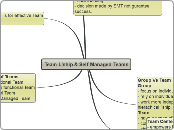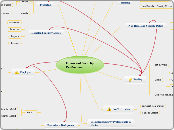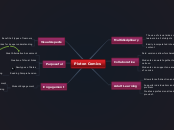Detailed Scope Review
Program
Provide initial BoD within 30 days
Constraints Management Support
The Consultant shall make reasonable assumptions, based on previous relevant experience, on the constraints management scope of work, such as impact studies, engineering work, estimation work and quotations, that will be undertaken by the ‘constraint owners’ themselves e.g. Western Power, Telstra etc, or their consultants.
This needs careful thought in what we allow for and caveat appreoriately
Supply Chain Modelling
Visualisation Tool
This needs to be discussed with Deloitte
The Consultant and Westport will jointly explore opportunities to enhance this user interface by linking it with Westport’s economic and environmental modelling to provide scenario and sensitivity analysis through a single dashboard.
The tool will be able to be handed over and run by Westport office staff in the absence of the Consultant for the purposes of certain briefings.
Be suitable for viewing and use by informed but not expert audiences including Project Partners, relevant Ministers, and key stakeholders.
Allow toggling of a limited number of key metrics (suggested by the Consultant and agreed by Westport) with a real-time response in the visual simulation to demonstrate the impacts on both container movement across the Supply-Chain and an agreed number of key metrics measures and costs (for each short-listed Option); and
Show, on demand, a summary of information for each Component (for each short-listed Option)
Show agreed important metrics (or parameters) to visualise potential bottlenecks across the Supply-Chain over the planning period and other key supply chain wide information such as carbon emissions, total cost, environmental impact quantum etc.;
Show each short-listed Option (Phase Three) overlayed on an aerial view of the Perth-Peel region, including Staging over the planning period and identification of footprints over existing land uses that may require acquisition (e.g land required to facilitate expansion of an IMT);
Fit-for-purpose visualisation tool to facilitate informed and timeline decision making processes
Deliverables
Subtopic
Phase 1
Gap Analysis Report
Incl. brief product scopes for all Deliverables for approval
BoD
Phase 1 (Initiation)
Geotechnical and Enviro Studies
Desk Study Only
Delivery of asdditional surveys excluded and on approval by Westport
Costing
Spec Production
Input to Decision Making Process
Validate the Base Case parameters with Westport’s Commercial and Economic workstream
Review the Performance Targets (for each Performance Measure)
Actively participate in a Base Case Parameter workshop (a concurrent project being delivered by Westport) to ensure outputs generated by the Consultant align to the Business Case project requirements
Ensure the costing strategy in alignment with Infrastructure Australia requirements and the expectations of private sector operators / investors (based on Consultants experience), or alternatives are approved by Westport;
Provide a brief strategy for Westport Stage 3 quantity surveying and costing identifying what approaches will be undertaken to minimise costs prior to Business Case consideration by Government
Work with the Economic Workstream project to agree input and output templates for the subsequent stages of The Project
Prepare a decision-making process plan which details the interfaces between the Commercial and Economic Workstream project and this Project with respect to; timing, scope, quality, format, responsibilities etc
Actively engage with the Commercial and Economic Workstream and ensure that the Interface Management Plan addresses ongoing engagement
Supply-Chain Integrated Design and Modelling
Whole of Supply Chain Component
identify those potential measures that apply at a whole-of-Supply-Chain level to drive increased Supply-Chain System performance - feed into Long List of Options
Supply-Chain Integrated Design
Ensure all design, drawings and documentation are aligned to the relevant output
Ensure all models provide the output data as required by the interrelated Westport projects
Develop interface processes with all models and the Supply-Chain Integrated System Model
Gap Analysis
Provide an initial BoD within 30 days
2x BoD Workshops
Stakeholder liaison
Key Assumptions
Mode Share
A general direction for a rail share over 40% should be considered, but optimisation is expected to arrive at the ideal share
LLOS
The (draft) LLOS report will also be provided to the Consultant on award which will include Westport agreed high level options and locations for future configurations of
road, rail, IMT/ECP/DC design (including infrastructure, operations, technology and governance) having been through an MCA, order of magnitude costing and rapid CBA.
o/d
The address of all container destination and origins, and address up to the top 25 trucking destinations (as of 2021 direct from port, or after loading from rail IMTs) and origins will be provided
Rail Frieght
Westport will provide a report on known inefficiencies and issues in network via the Baseline Constraints report.
Road freight
MRWA will provide the outputs of the road modelling and design processes at the relevant intervals to facilitate Consultant Supply-Chain modelling
A concept design and footprint for Anketell Road from Leath Road to Tonkin Highway will be provided
Number of terminal
operators
The Consultant shall consider two operators as a starting point for the design work noting this is subject to change (transitional arrangements, automation/technology
and competition policy approaches may suggest alterative to status quo).
Vessel size - Initial design vessel will be 14 000 TEU vessels (with scalability up to 18 000 TEU vessels during the next 50 years
Throughput / fleet - updated container shipping fleet and design vessel forecasts will be provided to the Consultant within 10 Business Days
The design should consider additional “buffer” capacity in each Stage of the Terminal Component development to ensure fluctuations in demand can accommodated without major disruption to operations due to infrastructure
constraints (‘resilience’).
The Supply-Chain will need to accommodate an upper end forecast of 1.2million TEU p.a. in 2030 and 3.7million TEU p.a. in 2070.
Design life - 100 years
Planning Horizon - June 2024 - June 2074 (50 years)
All Phases
Basis of Design









